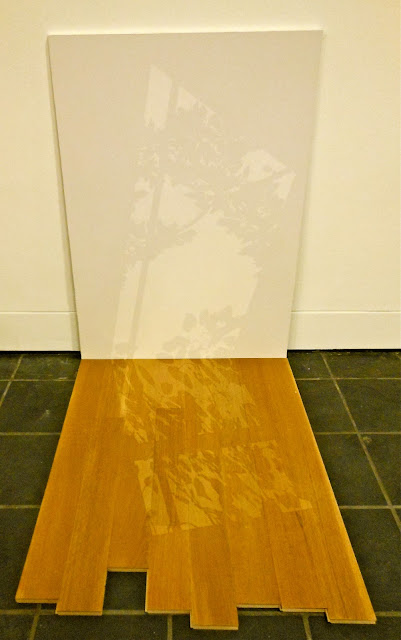 |
| Vivian Hyelim Kim, Visual Diary, 2013, detail. Installed at Virginia Center for Creative Arts. Author photo. |
 |
| Kim's cutting worktable at VCCA. |
But now Kim's up to something new. Pinned and taped with masking tape to the wall were all manner of weeds and seeds, the detritus and prizes of the forests, fields, and cow meadows that surround VCCA's bucolic campus. Each tiny arrangement of natural materials includes one man-made scrap: a cash-register tape, a tea bag, the folded corner of a page from an old book. The work is three-dimensional, tactile, and above all, ephemeral—doomed to swift decrepitude even as it is in the process of becoming.
 |
| Vivian Hyelim Kim, 1.17.13. (lichens and fungus) Installed at VCCA. Author photo. |
As Kim moves from place to place, traveling westward, eventually to Korea, where her parents live, she is also keeping a daily photographic diary, but one unrelated to this work. Eventually she will compile her photos into a book, a book that records her relationship to the presence of beauty every day of the year.
I readily confess that my instinctive reaction was that this wall of pretty arrangements seemed tentative and slight. Why bother? What could give it significance? But those two questions should always be asked consciously, for they're useless as long as they remain rhetorical. Kim's installation provoked worthwhile insights about the nature of art-making both in the grand scheme, and at this moment of 2013.
 |
| Materials for use in installation, in Vivian Hyelim Kim's studio at VCCA; |
These naturalizing trips are essentially opportunities for her to go outside and observe the landscape up close. She touches and visually examines matter that she's never seen before, even common leaves or twigs that we rarely pause to focus on. The installation materials are in themselves objects of beauty and wonder that invite her own investments of contemplative time. Though Kim will arrange them into a larger scheme, each element compels her attention as if it were itself an artwork. When she finally places all of them on the wall, each is removed from the nature's visual noise so its beauty and curiosity, now isolated, can be shared.
I was struck that Kim does not gather materials in order to transform them into something else, as one uses charcoal or clay to make art. These materials are not modified at all, but only by arrangement become the art work. The point is enjoyment of the materials for their own aesthetic qualities.
 |
| Vivian Hyelim Kim, 1.18.13, 2013. Installation at VCCA. Author photo. |
I found this community effort beautifully simple, as when elementary school children bring to their teacher items gleaned in a nature walk. Everything is acknowledged as useful and special, as worth of study: in this case, as having the properties of art. Anyone who thinks about the project and then studies a leaf with renewed curiosity becomes part of the artwork, or begins thinking like an artist.
As the work grows more participatory, in what sense, I wondered, did Kim consider it a diary? In writing a diary, most people distinguish one day from another by noting events that stand out, like a birthday, a holiday, or the day on which an unexpected or longed-for event occurs. Nothing in the series so far would seem noteworthy in a way that invite particular memories. Nothing outstanding marks New Year's Day, for example.
 |
| Pinecone "blossom" in Kim's VCCA studio, January 2013. |
A final noteworthy point about Kim's ephemeral art, is that it avoids many of the expensive impediments to art making that plague young, creative people. The assumption that fine art is durable art is the backbone of a system of endless expense for people who too often have little money to invest in their careers. At the dinner table at VCCA or any art colony, one hears repeatedly about the dilemmas of artists who push their pennies between a room to live in and a studio across town. Add to these the costs of documentation, framing, showing, shipping, and storing work, and it's evident that there are good artists who cannot practice professionally for purely financial reasons.
When I wondered what Kim would consider the "whole" of such an installation as her visual diary, it finally occurred to me that she is the whole. Her own ability to stand in one place and imagine the past and the future in the beauty of the present moment—that is its unity. Dust to dust, beginning and end, yet focused with every thought and sensation in the excellent here.
 |
|
Materials for use in
installation, in Vivian Hyelim Kim's studio at VCCA; experimenting with bittersweet as a pigment. |
























